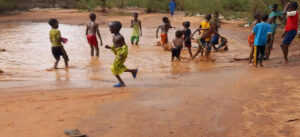
El-Nino, or heavier-than-normal rains, is a devastating issue that occurs every 3 to 5 years, causing huge rainfall and flooding in different areas of Kenya. The Kenya Meteorological Department had previously issued a warning on areas most likely to be affected, including North Eastern counties and the coast leading to Mandera and Wajir, as well as parts of Marsabit, Isiolo, and Garissa counties. The big question is are our children safe?
So far, at least 19 counties have been affected by El-Nino, and several families are displaced. Schools, sanitation, food, and storage facilities have been destroyed in Isiolo and other counties, leaving them in desperate need of humanitarian assistance. Other areas of concern include Garissa and Tana River counties, where families have been displaced and have nowhere to go.
Despite images on social media showing distraught children stranded alongside their parents with no hope of rescue, some children have made the most of the situation, having not seen rain in a long time.

Social media users have also expressed concerns on the safety of children during this period including: “El Nino forecast in Oct-Dec #Kenya “Children in Africa are among the most at risk of the impacts of climate change but are woefully neglected by the key climate financing flows required to help them adapt, survive & respond to the climate crisis”, #UNICEF”
“#Children are usually most affected during these disasters. They are at risk of drowning in #floods, health issues, they have no proper child friendly spaces for play. There is need for urgent support to those affected by this #ElNino. #climatechangeimpact,” said :Lilly on X.

The rains have also rendered roads impassable in some parts of the country mostly affecting school going children especially those sitting for National Examinations during this season. At least 2 children in Garissa County have died due to flooding experienced in Lagdera sub-county.Children in parts of the country experiencing the massive downpour have been exposed to waterborne diseases as a result of water contamination and clogging. Flooding recently experienced at Kakuma Refugee Camp in Turkana County displaced over 43 refugee families leaving 5 people dead including women and children having drowned in rivers that burst their banks.
Despite the havoc caused by the El-Nino, the government has continued to put in a raft of measures to avert the adverse effects caused by the unusual occurrence. Teams of young people have been deployed in parts of the country including Kibra and Ngumo in Nairobi County to help unblock drainage systems in hotspots identified as flood prone areas. This will in-turn favour children by preventing them from the risk of contaminating waterborne diseases, separation from their families through displacement and easy access to healthcare facilities when need be.
With the projection from the Kenya Meteorological Department indicating that 99 % of high rainfall is likely to be experienced up until January 2024, parents and guardians are urged to take safety precautions in order to safeguard their children from the effects of the heavy rainfall.
By Arnold Fedha.

Leave a Reply